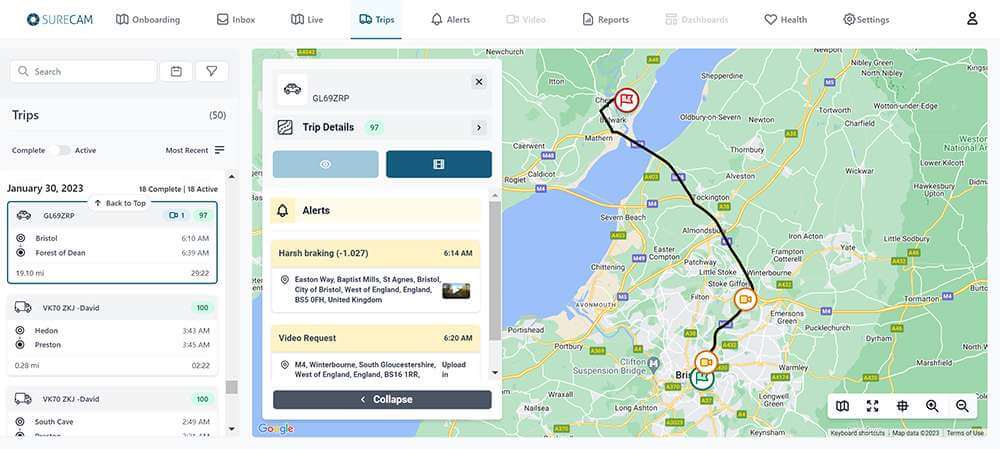The Role of Dash cams in Enhancing Eco-Driving and Fuel Efficiency

In the quest for more sustainable and efficient fleet operations, the spotlight has turned towards innovative technologies that can make a significant impact. Among these, AI-enhanced dashcams are emerging as a true changemaker. These advanced devices are doing more than recording road incidents—they’re revolutionizing fleet management and road safety. With a growing emphasis on eco-driving–a set of practices aimed at reducing fuel consumption and environmental impact—dashcams are quickly proving to be an indispensable tool.
AI-powered dashcams are shaping driver behavior, promoting fuel-saving techniques, and fostering sustainable trucking practices. By integrating cutting-edge technology with smart driving strategies, fleet managers are unlocking new efficiencies in green fleet management, making strides toward a more eco-friendly and cost-effective future.
Understanding Eco-Driving
Eco-driving encompasses a shift in driving practices with the goal of reducing fuel consumption, decreasing CO2 emissions, and promoting overall environmental sustainability. The essence of eco-driving lies in the adoption of driving techniques that maximize vehicle efficiency. It includes maintaining steady speeds; prioritizing gentle acceleration and braking; using gears efficiently; and minimizing idling time. Eco-driving has a big impact, not only in terms of environmental benefits but also in reducing operational costs for fleets.
The challenge lies in effectively implementing and monitoring eco-driving practices. It requires a detailed understanding of driving behaviors and the ability to provide real-time feedback and training to drivers. This is where modern technology, particularly dashcams integrated with AI, becomes invaluable. By analyzing driving patterns and providing actionable insights, these devices are crucial in fostering eco-driving practices within fleets.
Dashcams and Driver Behavior
Dashcams have evolved from mere recording devices to sophisticated tools capable of influencing driver behavior. When integrated with AI, these dashcams can analyze driving patterns, detect risky or inefficient driving practices, and provide feedback to drivers. This feedback can be immediate, allowing drivers to adjust their behavior in real-time, or it can be used in training sessions to demonstrate areas for improvement.
AI-enhanced dashcams can identify behaviors that contradict eco-driving principles, such as harsh braking, rapid acceleration, and excessive idling. By highlighting these instances, drivers become more aware of their driving habits and can make conscious efforts to adopt more fuel-efficient practices. Additionally, the data collected by these dashcams can be used by fleet managers to develop targeted training programs, set benchmarks, and monitor progress over time.
This proactive approach to managing driver behavior is pivotal in promoting eco-driving. It leads to a more environmentally friendly operation, significant fuel savings, and a reduction in wear and tear on vehicles, aligning with the goals of sustainable trucking and green fleet management.
How Dashcams Improve Driver Behavior
Dashcams, particularly those augmented with artificial intelligence, are increasingly becoming a critical tool in enhancing driver behavior, directly impacting eco-driving and fuel efficiency. These devices provide more than just a record of events; they offer a comprehensive analysis of driving habits. By continuously monitoring driving patterns, dashcams can identify and alert drivers to inefficient practices like abrupt stopping, rapid acceleration, and excessive idling. This real-time feedback encourages drivers to adopt smoother driving styles, which are essential for eco-driving.
Furthermore, the data collected by dashcams can be invaluable for training and coaching purposes. Fleet managers can use this information to create personalized training programs, focusing on specific areas where a driver may need improvement. Over time, this leads to a culture of continuous improvement and responsible driving within the fleet. As drivers become more conscious of their driving habits, they naturally tend to adopt more fuel-efficient practices, contributing to the overall goal of sustainable trucking and green fleet management.
Analyzing Fuel Efficiency
The role of dashcams extends beyond monitoring and improving driving behavior; they are also instrumental in analyzing and enhancing fuel efficiency. By collecting and interpreting data related to driving patterns, these devices provide insights into how driving habits directly impact fuel consumption. Sudden accelerations, harsh braking, and unnecessary idling are some behaviors that significantly increase fuel usage. Dashcams equipped with AI can detect these patterns and quantify their impact on fuel efficiency.
This analysis is crucial for fleet managers aiming to implement eco-driving practices. With detailed reports and analytics, managers can identify which drivers or routes are less fuel-efficient and why. This data-driven approach allows for targeted interventions, whether in the form of driver training, route optimization, or vehicle maintenance.
Moreover, the continuous monitoring provided by dashcams enables fleets to benchmark and track their progress in improving fuel efficiency. Over time, this data can reveal trends and help fleet managers make informed decisions about vehicle allocation, driver assignments, and even vehicle purchases based on fuel efficiency metrics.
Case Studies: Eco-Driving Success
One of the most enlightening case studies in eco-driving comes from the global shipping giant UPS. Their innovative approach to route planning, specifically their policy of minimizing left turns (in countries with right-hand traffic), underscores the impact of strategic driving on fuel efficiency. This policy, which might seem counterintuitive at first, is rooted in the complexities of the vehicle routing problem, a concept introduced in 1959 by George Dantzig.
UPS’s approach involves prioritizing right-hand turns to avoid waiting for gaps in oncoming traffic, thereby reducing idle time and the chance of accidents. Though this sometimes results in longer routes, the overall efficiency is significantly enhanced. Remarkably, UPS reports 10 million gallons less fuel used, 20,000 tons fewer carbon dioxide emissions, and 350,000 more packages delivered annually due to this strategy. The company has reduced its fleet by 1,100 trucks and cut 28.5 million miles of travel, despite the ostensibly longer routes.
This strategy's success was validated by the TV series "Mythbusters," which confirmed that avoiding left turns does save fuel. UPS’s experience raises a compelling question: if such a simple change in driving behavior can lead to substantial savings and environmental benefits, can this approach be more widely adopted in everyday driving, particularly in urban commutes?
Tips for Implementing Eco-Driving
With growing awareness of environmental issues and the rising cost of fuel, companies are seeking ways to encourage eco-driving practices within their fleets. This not only helps in reducing operational costs but also contributes to a company’s green credentials. Here are some effective tips for implementing eco-driving in your business.
Educate and Train Drivers. The first step in promoting eco-driving is education. Drivers need to understand the importance of eco-driving and how their driving habits can impact fuel efficiency and the environment. Provide training sessions that cover key eco-driving techniques such as smooth acceleration and braking, maintaining a steady speed, using gears efficiently, and minimizing idling. Regular training ensures that these practices become a part of every driver’s routine.
Use Telematics and Monitoring Tools. Technology can play a significant role in supporting eco-driving. Telematics systems and GPS tracking can monitor driving behavior, providing data on aspects like speed, idling time, and route efficiency. You can significantly cut costs with vehicle tracking, as the data you collect can be used to give feedback to drivers and identify areas for improvement. Some systems also offer real-time feedback to drivers, alerting them to inefficient driving practices as they occur.
Set Realistic Goals and Incentives. Setting achievable goals for fuel consumption and emission reduction can motivate drivers to adopt eco-driving practices. Recognize and reward drivers who meet or exceed these goals. Incentives could range from simple recognition in company communications to financial bonuses or other rewards. This not only encourages eco-driving but also fosters a positive company culture.
Plan Efficient Routes. Route planning is crucial in eco-driving. The shortest route is not always the most fuel-efficient. Use route planning tools to find the most efficient routes that avoid traffic congestion and reduce travel distances. This not only saves fuel but also reduces wear and tear on vehicles.
Prioritize Regular Vehicle Maintenance. Properly maintained vehicles operate more efficiently and are essential for eco-driving. Ensure that vehicles are regularly serviced, with particular attention to tire pressure, engine oil, and air filters. A well-maintained vehicle consumes less fuel and is less likely to have breakdowns, which can lead to inefficient routes and increased emissions.
Promote a Culture of Sustainability. Encouraging eco-driving is part of fostering a broader culture of sustainability within your company. Engage with your staff about the importance of environmental stewardship and how eco-driving fits into this vision. This can help employees feel that they are contributing to a larger goal, increasing their commitment to eco-driving practices.
Monitor and Review. Continuously monitor the results of your eco-driving initiatives and review them regularly. This helps in understanding what is working and what needs improvement. Use the data collected from telematics systems to assess progress and make necessary adjustments to your strategies.
Future Trends in Eco-Driving
The future of eco-driving looks promising, with emerging trends indicating a shift towards more sustainable and efficient fleet operations. Advancements in AI and machine learning will further refine the capabilities of dashcams and telematics systems, providing even more precise data on driving patterns and fuel efficiency.
Autonomous and semi-autonomous vehicles will also play a significant role in promoting eco-driving. These vehicles can optimize driving behaviors in real-time, significantly reducing fuel consumption and emissions.
The integration of electric vehicles (EVs) into fleets is another trend to watch. As the infrastructure for EVs expands, fleets will likely adopt these vehicles to reduce their carbon footprint further.
SureCam Helps Fleets of All Sizes Leverage Eco-Driving Practices
SureCam's AI-powered fleet dashcams with GPS tracking are at the forefront of transforming fleet operations. By enhancing eco-driving practices and fuel efficiency, these advanced tools offer a future-proof solution for fleets aiming for sustainability and cost-effectiveness. For those interested in experiencing the benefits firsthand, SureCam is the solution. Schedule your free demo and see how our technology can optimize your fleet operations and promote a better bottom line for your company—and a healthier planet.

Book a demo today!
SureCam offers GPS vehicle tracking, live video, and real-time alerts for efficient fleet management. Get a Demo


